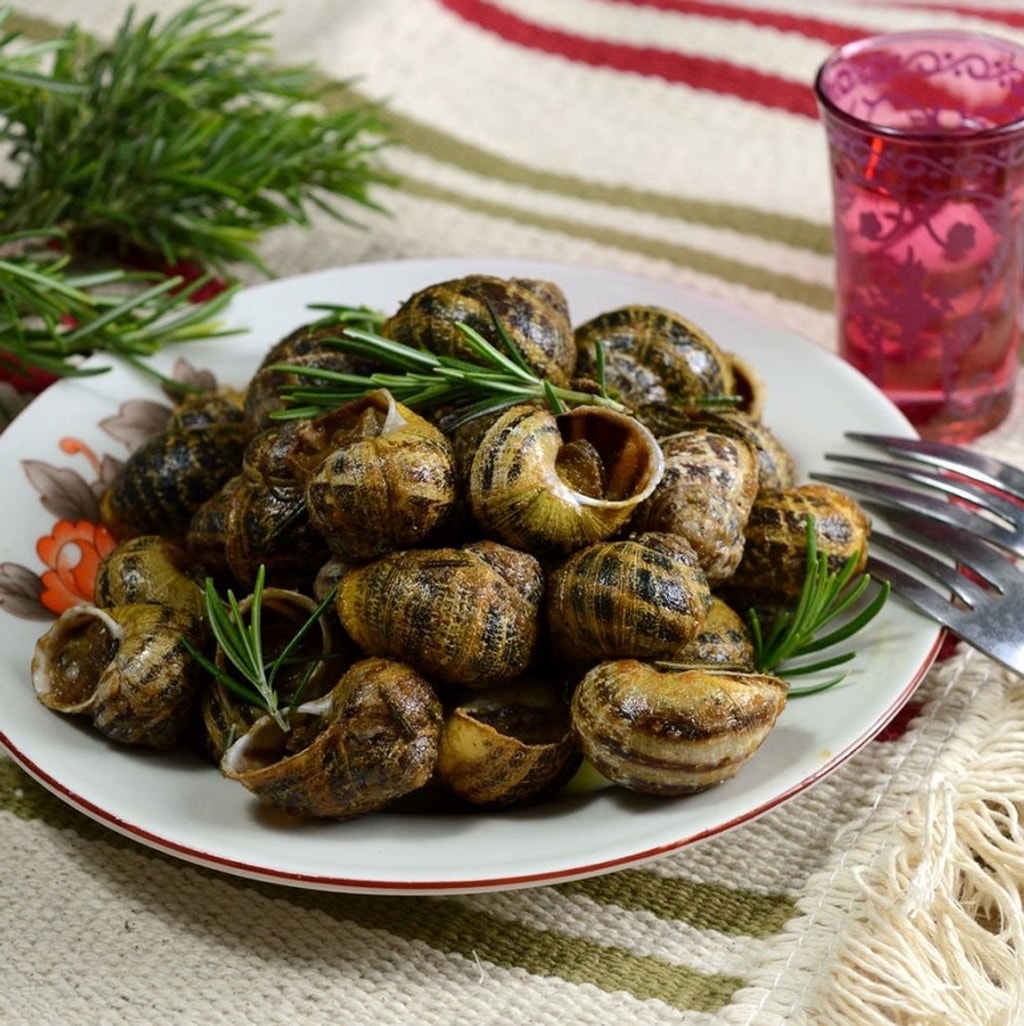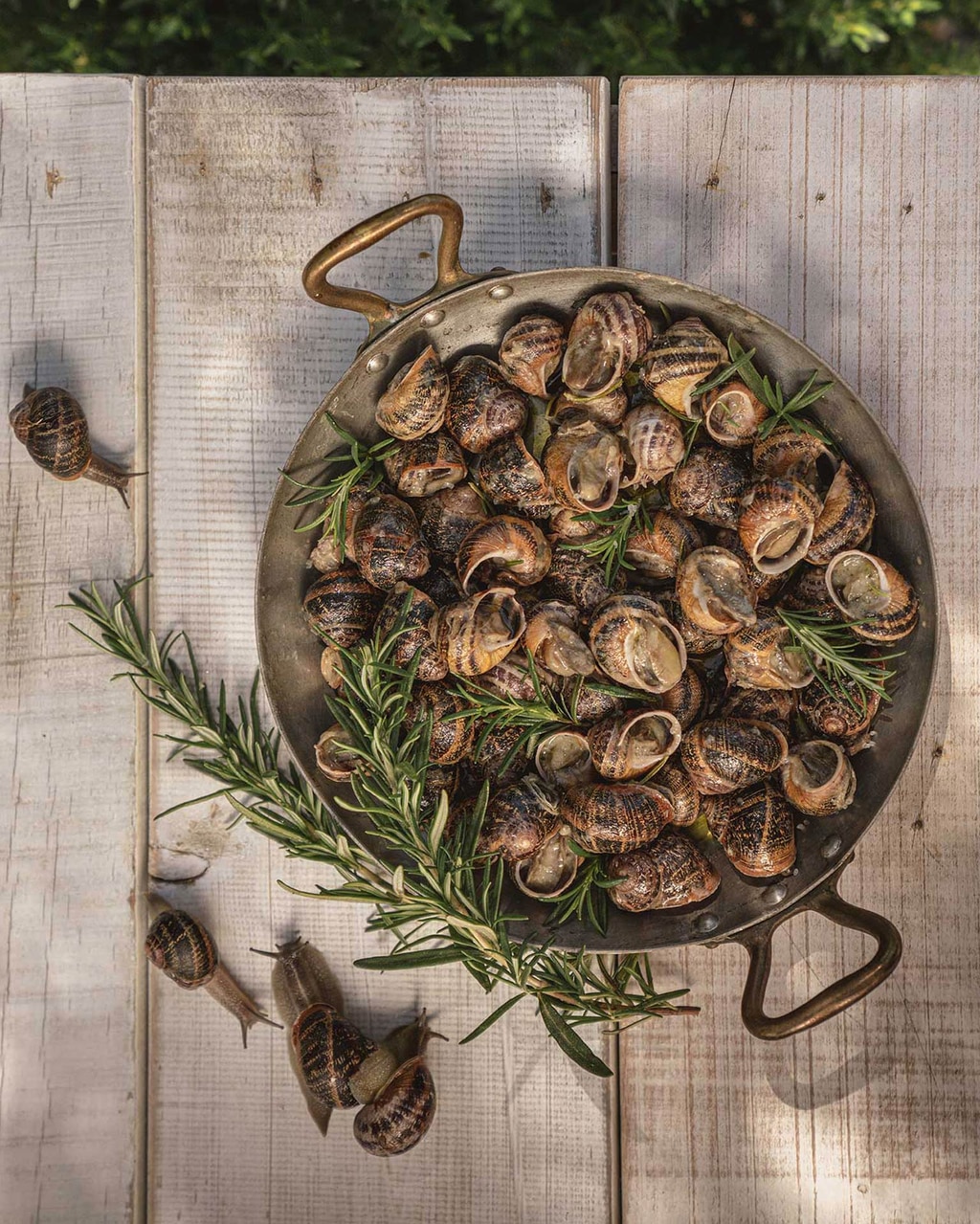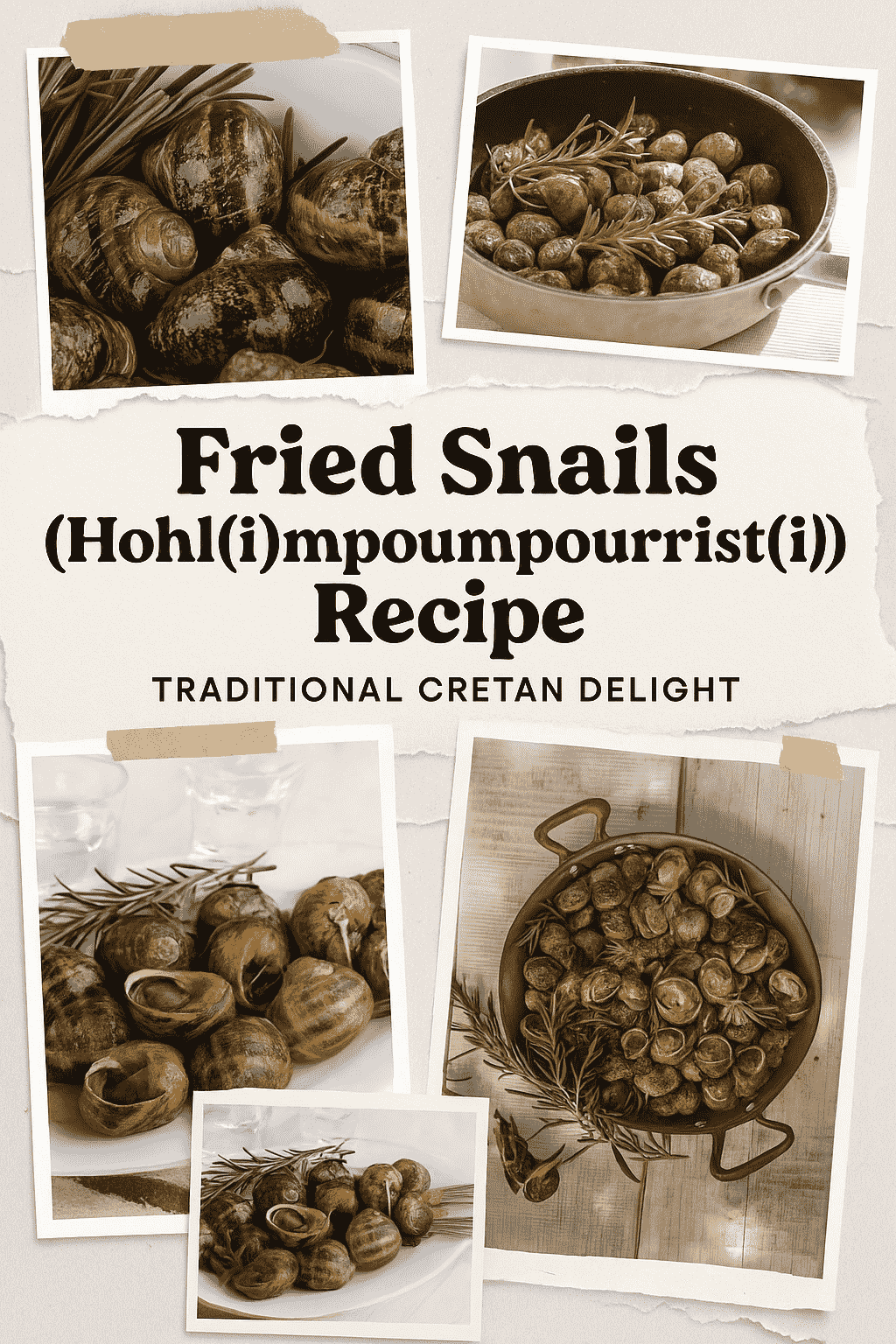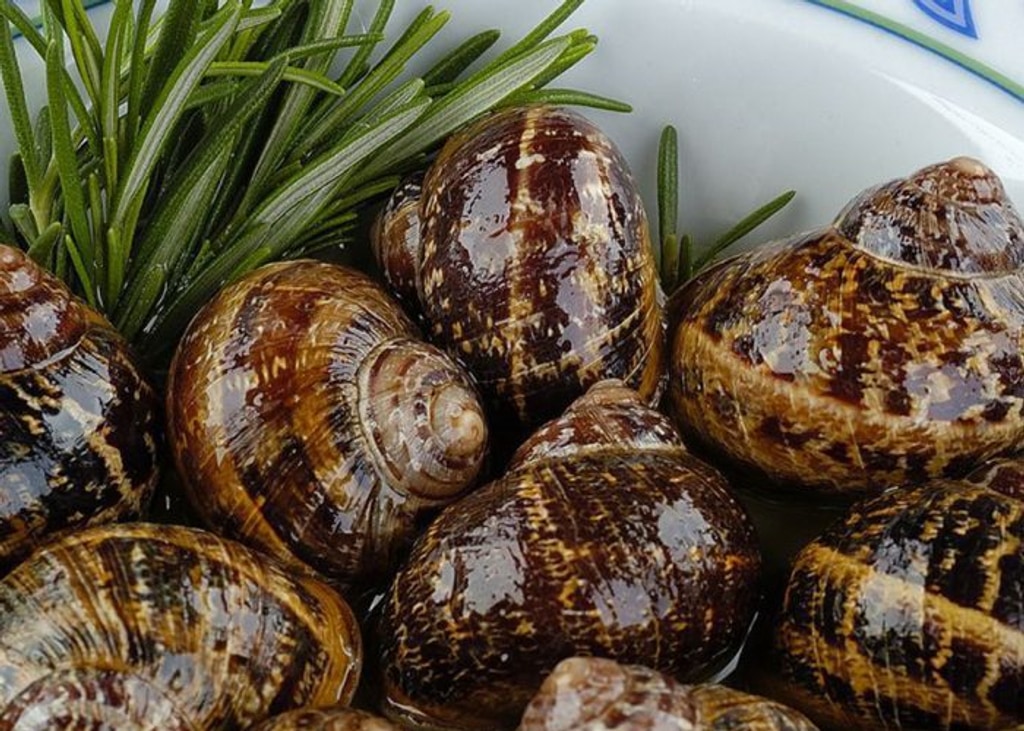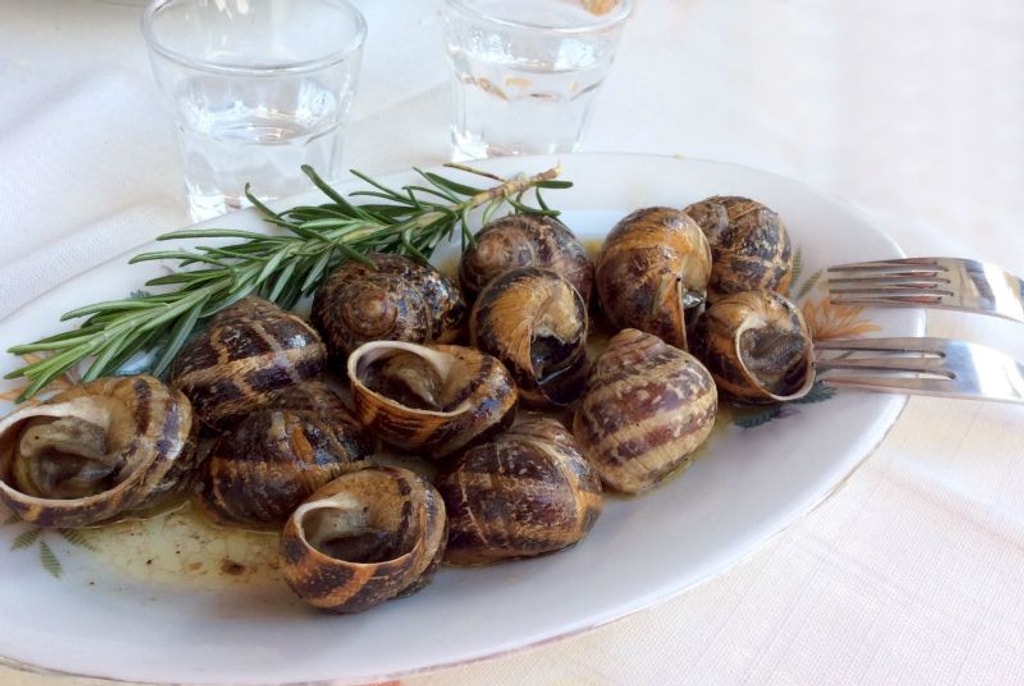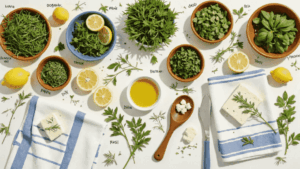Fried Snails (Hohl(i) mpoumpourist(i)) Recipe – Traditional Cretan Delight
Crete is a land of contrasts, where rugged mountains meet the blue sea, and ancient traditions are still very much alive in everyday life. One of the most fascinating elements of Cretan culture is its cuisine. The Cretan diet, considered one of the healthiest in the world, is based on fresh vegetables, wild herbs, olive oil, and seasonal local products. Among the lesser-known dishes that locals adore but often surprise visitors is the humble yet iconic dish of Hohlioi Mpoumpouristoi, or fried snails. This may sound like a dish for the brave-hearted, but in Crete, it’s a beloved delicacy full of flavor, history, and heart.
What Are Hohlioi Mpoumpouristoi?
The name might be hard to pronounce at first, but once you’ve tried this dish, you’ll remember it forever. “Hohlioi” means snails in the local dialect, and “Mpoumpouristoi” refers to the cooking method. The name comes from the sizzling sound snails make when they hit the hot pan. The snails are fried with rosemary, vinegar, and a generous amount of olive oil, creating a savory, earthy, and aromatic dish. This dish has been prepared in Cretan households for centuries and is still served regularly in tavernas across the island.
Why Snails?
Many visitors ask: why snails? Aren’t they hard to cook or unpleasant to eat? Actually, in Crete, snails are a sustainable and protein-rich food that grows wild in the mountains after it rains. Locals go out and collect them fresh, then purge and clean them thoroughly before cooking. Far from being a survival food, they’re considered a seasonal delicacy and are often served at family gatherings, festivals, and Sunday meals. Snails are rich in protein, low in fat, and full of minerals like iron and magnesium. They also have a unique texture and flavor that’s enhanced by the simple ingredients used in this traditional recipe.
Ingredients You’ll Need
The best part about Hohlioi Mpoumpouristoi is how simple it is to prepare. The ingredient list is short, but the result is packed with flavor. You’ll need:
-
500 grams of cleaned snails
-
3 tablespoons of flour
-
1/2 cup of extra virgin olive oil
-
3-4 sprigs of fresh rosemary
-
2 tablespoons of red wine vinegar
-
Sea salt to taste
These ingredients come together in a harmony that perfectly reflects the Cretan spirit – rustic, honest, and deeply satisfying.
Where to Get the Snails
If you’re not in Crete, don’t worry – you can still make this dish. While locals pick them from the hillsides after rainfall, you can often find edible snails at specialty food markets, Mediterranean delis, or online. Look for Helix aspersa snails – the same kind used in French escargot. You can buy them live or pre-cleaned and frozen. If you get them live, you’ll need to purge them by feeding them flour for a couple of days, then fasting them and rinsing them multiple times. If using frozen snails, make sure they’re fully defrosted and patted dry before cooking.
Step-by-Step Recipe for Hohlioi Mpoumpouristoi
Step 1: Prepare the Snails
If using fresh or live snails, you need to clean them well. Rinse under cold water several times, removing any debris or dirt. If you’ve purged them, make sure they’ve fasted for at least 24 hours. If frozen, simply rinse and dry thoroughly.
Step 2: Coat in Flour
Place your clean snails in a bowl and sprinkle them with flour. Toss them gently so the flour lightly coats the snail’s opening. This helps create a crispy texture when they hit the hot oil.
Step 3: Heat the Olive Oil
In a large, heavy-bottomed frying pan, heat your olive oil over medium-high heat. You want enough oil to just cover the bottom of the pan, but not so much that you’re deep frying.
Step 4: Add the Snails
Place the snails in the pan with the opening facing down. This is key to cooking them properly. The meat inside will start to sizzle, and the flour will brown and crisp. After a few minutes, turn the heat to medium and add the fresh rosemary sprigs.
Step 5: Season and Add Vinegar
After about 8-10 minutes of frying, the snails will be golden brown and aromatic. Sprinkle a generous pinch of sea salt and then pour in the vinegar. It will sizzle and create a tangy, flavorful steam that infuses the snails with acidity and depth. Let it reduce slightly before removing from heat.
Step 6: Serve Hot
Hohlioi Mpoumpouristoi should be served immediately while still hot and sizzling. You can serve them as an appetizer, a main course, or as part of a meze platter with crusty bread, olives, and wine.
What Do They Taste Like?
The flavor of fried snails is rich and earthy, with a slight chewiness similar to mushrooms or calamari. The rosemary and vinegar cut through the natural brininess of the snails, creating a perfect balance of fresh and savory. They’re not slimy or strange – they’re aromatic, crispy, and full of texture. If you’ve tried escargot in France, these are more rustic and less buttery. In fact, many visitors say they prefer the Cretan version because of its clean, herbal profile.
When and Where to Try Them in Crete
The best time to eat Hohlioi Mpoumpouristoi is during or after the rainy season, usually in spring and autumn, when snails are easy to find. Local tavernas in the villages of central and eastern Crete often feature this dish. Look for it in mountain villages like Archanes, Anogeia, or even the Lassithi Plateau, where traditional Cretan cooking is still alive and well. Many locals still go snail-hunting as a family tradition, and it’s not uncommon to find them selling fresh snails by the roadside.
What to Eat With Hohlioi Mpoumpouristoi
This dish pairs beautifully with fresh bread, local cheese like graviera or mizithra, and a green salad dressed simply with lemon and olive oil. It’s commonly served alongside wine – typically a dry white or even a homemade raki. It’s not a heavy dish, but the olive oil and flour give it enough body to be satisfying on its own. If you’re serving it as part of a bigger meal, consider including other Cretan specialties like dakos, lamb with stamnagathi (wild greens), or fava.
Tips for Cooking at Home
Always use high-quality olive oil – this is not just for flavor but also for authenticity. Cretan olive oil has a strong, peppery character that brings this dish to life. Don’t skip the rosemary or vinegar – these are essential for the aroma and balance. If you’re unsure about cooking snails for the first time, start with a small batch to get the texture right. It’s not complicated, but getting them crispy without overcooking takes a bit of practice.
Making It Your Own
While the traditional recipe is simple, you can tweak it slightly to suit your taste. Some cooks add garlic or a splash of white wine. Others use thyme instead of rosemary. But most Cretans will say – keep it classic. This dish is all about honoring the ingredients and keeping it rustic. If you want to serve it differently, try pairing it with roasted vegetables or even pasta. But honestly, a simple plate, a slice of bread, and good company is all you need.
Why It’s Worth Trying
Eating snails might be outside your comfort zone, but this dish is one of the most authentic tastes of Crete you can experience. It’s a window into how people lived off the land and used what nature gave them. It connects you to a way of life that values simplicity, resourcefulness, and community. Whether you try it in a village taverna or cook it at home, Hohlioi Mpoumpouristoi offers a taste that’s both traditional and surprisingly refined.
Conclusion
Fried snails might not be the first thing that comes to mind when you think of Greek cuisine, but they’re a true Cretan treasure. Hohlioi Mpoumpouristoi is more than just a dish – it’s a tradition, a story, and an experience that captures the heart of the island. If you ever find yourself in Crete, don’t miss the chance to try it. And if you’re adventurous in your kitchen, this simple, satisfying recipe will bring a bit of Mediterranean magic to your table.



